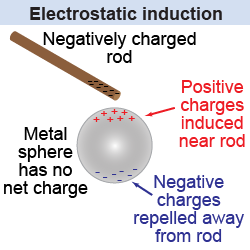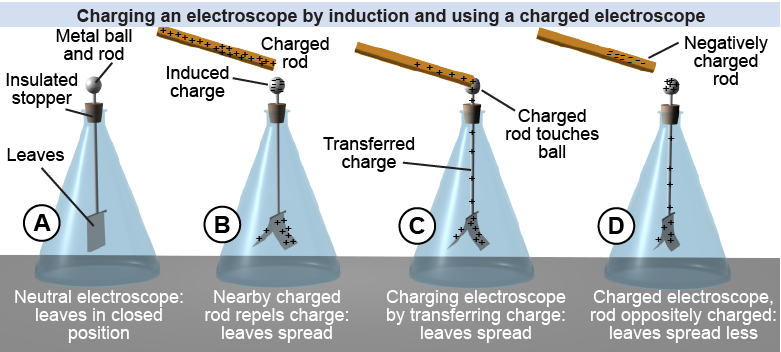|
Electrons in insulating materials may be transferred by friction. For example, rubbing a glass rod with fur transfers some electrons from the fur to the rod. In a similar way, separating the two pieces of tape in Investigation 18C caused some negative charge to transfer from one tape to the other. The tape losing the negative charge became slightly positive and the one gaining the negative charge became slightly negative. With the tapes, you observed that uncharged objects in the room attracted both pieces of tape! How does an object attract both positively and negatively charged
pieces of tape? 
|
 To answer the question, assume you have a negatively charged glass rod and you bring it near an uncharged metal sphere. Electrons nearest the rod are repelled—creating a slight excess of positive charge in the metal near the rod. The excess positive charge causes the rod to be attracted to the metal! With a glass rod the force is too small to feel but the attraction is strong enough to visibly bend a charged piece of tape. This is an example of electrostatic induction, which occurs when a charged object causes charges to rearrange on a different object.
To answer the question, assume you have a negatively charged glass rod and you bring it near an uncharged metal sphere. Electrons nearest the rod are repelled—creating a slight excess of positive charge in the metal near the rod. The excess positive charge causes the rod to be attracted to the metal! With a glass rod the force is too small to feel but the attraction is strong enough to visibly bend a charged piece of tape. This is an example of electrostatic induction, which occurs when a charged object causes charges to rearrange on a different object. 
 |
The explanation above applies to how electrostatic induction works in conductors, materials in which the electrons are free to move around. In nonconductive or dielectric materials, such as a balloon or Styrofoam™, the electrons are tightly bound to the atoms or molecules and are not free to move around. In these materials, the electrons can move slightly within the molecules—moving to the near side of the molecule or to its far side—in response to the outside electric charge. This is a microscopic form of polarization of the molecules that creates a similar effect to electrostatic induction in conducting materials. 
|
An electroscope is a sensitive instrument that uses electrostatic induction to detect electric charge. In Figure B below, a positively charged rod is brought near a neutral electroscope. Negative charges are attracted toward the rod by induction, leaving a net positive charge on the leaves. The lightweight leaves spread apart because they have similar charges. 
|

|
If the rod touches the electroscope briefly (C) some of the charge is transferred to the electroscope. The electroscope becomes charged and its leaves stay spread apart. The leaves of a positively charged electroscope come closer together when a negative charge is near the electroscope (D). The leaves spread farther apart when a positive charge comes near. The charged electroscope can be used to determine whether an external charge is the same or opposite to the object that originally charged the electroscope. 
|
How can you use an electroscope to detect electric charge?
 |
When an electroscope is in a neutral environment, the leaves hang flat together. If a charged object is brought near it, the leaves will spread apart. 
|
In the example of electrostatic induction in the top figure on the page, what would happen if the rod were positively charged?
 |
If a positively charged rod were brought near the sphere, the charges in the sphere would rearrange themselves—but this time bringing the negative charges near the rod. The rod would still be attracted to the sphere! 
|

